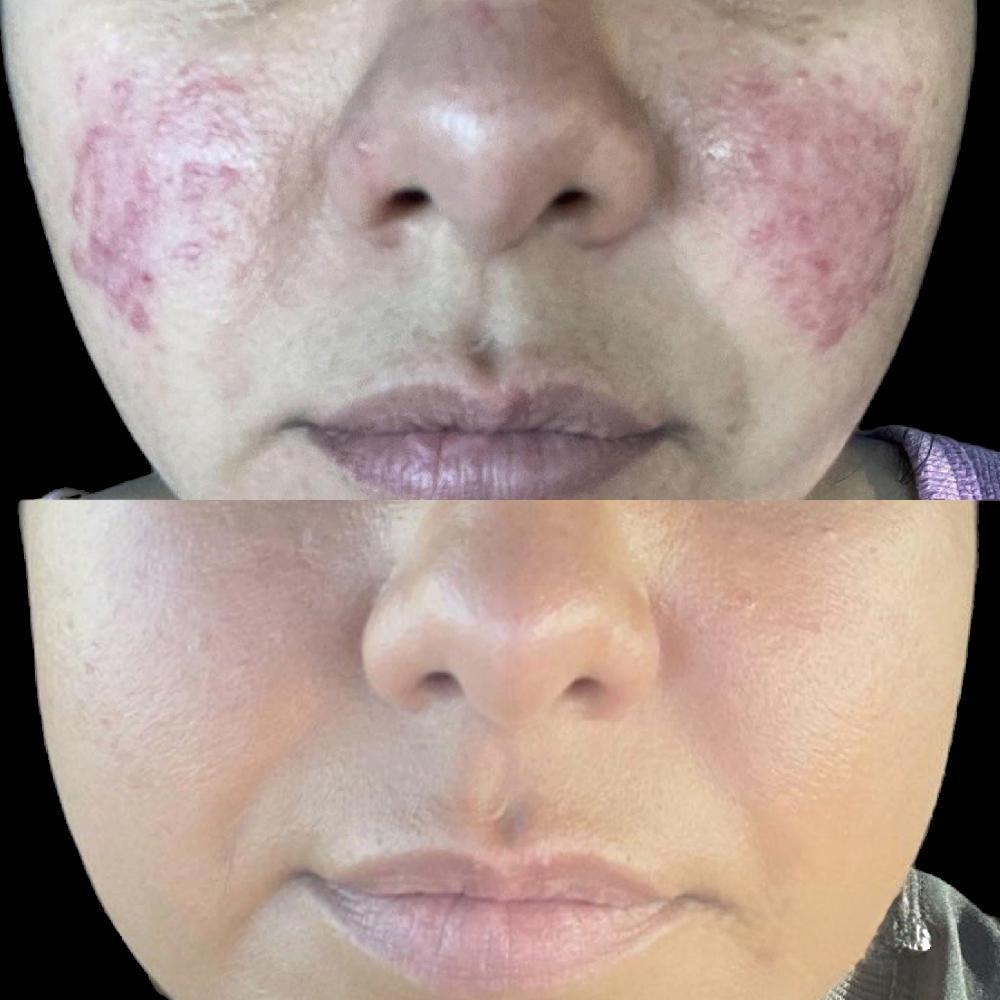
The VBeam is a pulsed-dye laser. The laser energy is delivered in pulses and a dye is used to generate laser beams of different colors. VBeam is used to treat dilated blood vessels, as in rosacea, and is often called a vascular laser. The target of the vascular laser is hemoglobin, the red protein in blood cells in the blood vessels. Skin cells that surround the dilated blood vessels are not damaged.
The Vbeam procedure stands alone as the gold standard in pulsed-dye laser treatments. This device treats a wide range of skin issues that often negatively impact one’s appearance and self-confidence. The Vbeam can be used to treat port wine stain birthmarks, leg veins, warts, vascular lesions, stretch marks, acne scars, age spots, facial and spider veins, rosacea, and pigmented lesions. The Vbeam works by delivering pulsed laser energy that passes through the dermis and epidermis skin layers. This energy is emitted at a wavelength of 595nm and is absorbed by the oxyhemoglobin in the blood cells instead of the surrounding tissue. This means that there is far less damage than similar treatments, allowing for a quicker healing time. Another advantage of the Vbeam is how quickly it operates. It fires a more intense burst of laser energy than older pulsed-dye lasers, but the pulse of the Vbeam lasts for only 0.45 milliseconds as opposed to the old 40 milliseconds. Again, this reduces stress upon the patient’s skin.
How do I know if I need the VBeam?
If you have too much redness due to dilated blood vessels in your nose, cheeks, chin, or other parts of your face, you may benefit from treatment with the VBeam. The VBeam is also good for removing angiomas, small red clumps of blood vessels. Red birthmarks, called port wine stains, can be treated with the VBeam, as can stubborn warts, scars, and bruises and sun damage on the neck and chest. Persons with a history of cold sores or herpes simplex virus should not have this procedure until they are pre-treated for these conditions.
Is VBeam Painful?
VBeam is not painful enough to require anesthesia. The short pulses feel like cold and hot snaps on the skin. A stream of cold air directed at the treated area helps to minimize discomfort. We will ensure your comfort with numbing cream prior to your procedure.
How does VBeam work?
The VBeam is a pulsed dye laser, which means that the laser energy is delivered in pulses and a dye is used to generate laser beams of different colors. Since the VBeam is used to treat dilated blood vessels, as in rosacea, it is often called a vascular laser. The target of the vascular laser is hemoglobin, the red protein in blood cells in the blood vessels. Skin cells that surround the dilated blood vessels are not damaged.
What benefits can I expect?
In rosacea, you can anticipate 50% to 75% improvement after 3 to 5 treatments. Since rosacea is a chronic condition we recommend 1 to 2 maintenance treatments per year. Port wine stains require more than 5 treatments.
What are the risks and side effects?
Be sure to tell us if you have a history of herpes simplex because laser energy can activate the virus. Otherwise, no preparation is necessary. The VBeam is one of the safest lasers that are in existence. Scarring, infection, and blistering are extremely rare. Bruising is the most common side effect. It is important to wear the eye protection that we provide throughout the treatment to shield your eyes from the light. Prior to treatment all potential risks and side effects will be discussed with you by our staff.
Can V-Beam be combined with other treatments?
Yes. VBeam treatment can be combined with most other treatments. If you combine botulinum toxin or injectable fillers with the VBeam, the laser treatment is done first.
What else can I anticipate after the treatment?
The treated area will look more red and swollen for a few hours or, in rare cases, up to several days. Bruising may occur when very large blood vessels, port wine stains, warts, or scars are being treated.










